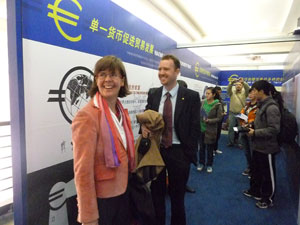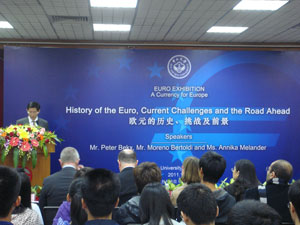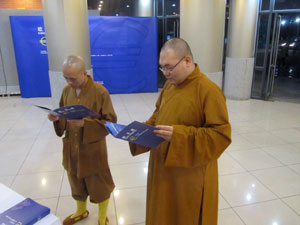

Accessibility tools
Service tools
Language
Navigation path
12.12.2011 - What's the purpose of the euro and why does it matter to China?
The answers to these questions are included in an information campaign on the euro in China, which was launched in November. With China being an increasingly important partner to the EU (and with the EU being China's largest export market), there is strong interest in and also support for the euro area among the Chinese leadership. Contacts with our regular counterparts are frequent and normally very good. The tone in the media is less supportive - bordering hostile, at times.



In order to raise awareness about the euro, the sovereign-debt crisis and the many measures taken to address it, DG ECFIN has initiated an information campaign on the euro in China. The campaign consists of a stand-alone audio-visual exhibition manned by student volunteers who distribute information booklets and souvenirs. It is complemented with events at different universities in which senior EU staff engage with primarily Chinese students (as important decision makers in a longer-term perspective). University leaders and representatives from the PBoC (China's central bank) are also invited to speak. The invitation of press to the seminars and responding to their questions at the margin aims at contributing to a more nuanced reporting on the euro in China. Starting in Chengdu mid-Nov., the euro exhibition is set to travel to a handful of cities in China during the winter of 2011/2012.
Mary McCarthy travelled to China to participate in the first two events, in the cities of Chengdu and Xiamen, together with Annika Melander, who is seconded to the EU Delegation to China from DG ECFIN. Sichuan University in Chengdu (with a population of 10 mio.) has over 70,000 students and is the largest university in Western China. Xiamen is located on the coast of the Taiwan straits and has a population of 3.5 mio. 'only'. The main impressions from the first two events are that students are extremely eager to learn more about the euro and the crisis, and also more generally about the EU and the peaceful integration it has gone through, as well as its role as a partner to China. Prior knowledge of EU matters clearly varied. Some 2.000 students saw the Chengdu exhibition, while about 4.000 visited it in Xiamen. Using social networks help to reach out to an even larger audience, with the 'euro rabbits' being an extremely popular prize (in the year of the rabbit) to the on-line quizzes.
In a third stop, Peter Bekx and Moreno Bertoldi met up with Annika Melander to engage with students in one of the most important trade hubs in southern China: Guangzhou (with some 11 mio. urban residents). The 150 students in Sun Yat-Sen University that attended the seminar on "the history of the euro, current challenges and the road ahead" proved to be extraordinarily active and well informed; posing many and very good questions. Over the first four days, about 3.000 students and members of the public visited the exhibition. The comments posted on social networks between students suggest that there is an increased interest also in other cities to know more about the euro.
The euro exhibition is set to travel north in China after the Christmas and (Chinese) New Year break.
Additional tools